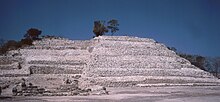Jaina (necropolis)

Jaina (from Mayathan ja'ilnah ("house of water") or ja'nal ("place of water") is an island off the west coast of the Yucatán peninsula in the Mexican state of Campeche , about 50 kilometers (as the crow flies) northwest of the city of the same name located. It houses a large Mayan necropolis and is particularly known for the numerous finds of small sculptures from the classical period .
location
The island, located in the west of the Yucatán peninsula in the Gulf of Mexico , has an area of almost one square kilometer and is separated from the mainland by a strait about sixty meters wide. In Mayan times there was an artificial dam connecting the island to the mainland. The island itself is very swampy due to its low height above sea level and the resulting high groundwater level and criss-crossed by many small streams. In order to be able to cultivate the area, the residents poured rubble that had been brought in to form terraced hills.
The west is in many cultures with the setting of the sun, i.e. H. associated with night or death. So it is not surprising to find something similar in the Maya area, but no necropolises have been discovered on the neighboring islands.
necropolis
The religious and administrative center of Jaina was a plaza in the middle of the island, which was surrounded by the so-called Zacpool pyramid complex. This consisted of a multilevel temple pyramid , several smaller squares and a ball playground . The residential areas of the population were located in the individual districts that were grouped around the center. Most of the graves were also found here; Between 500 and 1000 AD, around twenty thousand burial sites were probably laid out, of which only a good thousand have been archaeologically recorded and examined. It is still unclear whether the dead all came from the island itself or whether they were brought here from the closer or even more distant surroundings.
The burial ritual of the Jaines is still a mystery. All corpses were placed in their mouths with jade beads and then wrapped in red-dyed shrouds in a crouched position. While the adults were laid in a normal grave, children and babies were mostly buried in clay jars, which were then lowered into the graves.
Figurines
Many of the archaeological finds are small figures or sculptures made of painted terracotta , which were probably not made on the island itself - at least the clay did not come from here. The figures produced from around 500 AD mostly have human figures as a motif and are made in great detail. The individual parts of the sculptures were individually designed and shaped in this early period. Body features such as the head, hairstyle, clothing and jewelry are very carefully worked out. In addition, the figures cover the entire spectrum of human emotions, as they were designed in a wide variety of ways, especially with regard to facial expressions, gestures and posture. Pain, illness or even physical disabilities such as dwarfism were shown. Architectural, animal or god motifs were much rarer.
As far as we know, the figurines are not directly related to the buried - for example, warrior statuettes were found in women's or children's graves.
Since the importance of Jaina as a religious center steadily increased from the eighth century, the demand for such sculptures also increased among the Maya. From 800 to the turn of the millennium at the latest, only mass-produced goods were produced that could be produced faster and more effectively using negative molds . The characters lost much of their charisma during this period.
For today's research, the figures offer an impressive insight into the society of the Maya, especially the nobles, because many of the small statues represent members of the religious and social elite or high-ranking warriors. For what purposes the figurines were placed in the graves is unclear - In any case, they weren't eating or drinking vessels.
Most of the figurines have small holes, which were primarily responsible for the necessary temperature and pressure equalization during the firing process.
photos
Ball player with yoke stone
literature
- Christian Prager: Jaina - the island necropolis . In: Nikolai Grube (Ed.): Maya. God kings in the rainforest . Könemann-Verlag, Cologne 2000, ISBN 3-8290-1564-X , p. 308f.
- Extensive bibliography on the Jain figurines
Web links
See also
Coordinates: 20 ° 12 ′ N , 90 ° 29 ′ W








